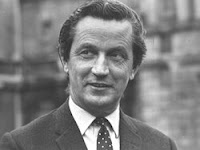This is the second in a series of posts written Dr Diarmuid O'Driscoll looking back on a 60 year career in obstetrics and gynaecology. These pieces were first published in The Matrix, the newsletter of the Institute of Obstetrics and Gynaecology, RCPI, who have kindly agreed to their being made available on this blog. The first part is available here.
 |
| Dr Noel Brown |
I came home to Ireland and moved to Galway because there was a temporary post advertised in the field of Obstetrics. The 'temporary' post lasted nine years. It so happened that the post became the most sensitive medical post in the country because it was intimately involved with the Mother and Chid Scheme and Noel Brown intended to appoint the first Obstetrician / Gynaecologist in his new scheme there. In 1950, Browne proposed a scheme which would provide maternity care for all mothers and healthcare for all children to be funded by the taxpayer. But when I read the account of Archbishop McQuaid's ultimatum to Mr. Costello I can understand that although an interview was held for the post no appointment was made. This led to Noel Brown's resignation in 1951.
Galway at that time had a population of 30,000 every one of them a character, and was a place much different from the modern Galway of today. At this time there was only one specialist obstetrician practising solely between Derry and Limerick. At the time everybody was doing Maternity from surgeons to physicians and general practitioners. In fact, back then many regarded maternity as the main stay of general practice. The reasoning being that if you had the mother as a patient, generally you got the whole family too.
In my first year in Galway I had only one or two private patients. People just didn't understand the concept of a specialist obstetrician / gynaecologist. To keep myself occupied, I undertook the care of a case of massive pulmonary embolism, which occurred in an acquaintance of mine. This eventually turned into a massive lung abscess. I treated this with penicillin inhalation rather like a modern inhaler for asthma. The patient recovered and evacuated the abscess spontaneously. I published this case in the Lancet. I think that we took the first Pap smear in the island there, largely through the co-operation of Prof John Kennedy who was the foremost Pathologist of his day. I performed one of the first exchange transfusions in Ireland in 1950, and Prof Lavelle and myself published a paper in the Lancet in the mid- fifties describing the use of concentrated plasma in restoring the blood fibrinogen in the case of disseminated inta vascular coagulation complicating a missed abortion.

Those days in Galway our rivers were less polluted than today, and much more plentiful, and I was a keen fisherman. I remember on one occasion I was fishing in a small river about ten miles from Galway. I had just hooked a salmon when I saw a Garda (Policeman) running towards me, when he reached the river he announced, "you are wanted immediately at the hospital". Was I to cut the line and let the Salmon go? With some luck, and perhaps a certain amount of skill I landed the fish, then proceeded in the car to the hospital to deliver the baby. So I had landed a salmon and delivered a baby within half an hour. Similar interruptions would become a feature of my pastimes, and later when I lived in Wexford there were many a golf game interrupted with dashes from the links to the hospital.
There were certain incidents that stand out during my time in Galway. I remember the impact of Hurricane Debbi, which was more frightening than any blitz I experienced during the war. Another was the loss of the Lufthansa plane off Galway Bay with a loss of overt 100 lives. As I was medical director of the Red Cross at the time and I had to attend the carnage. We won the Presidents cup on three consecutive occasions and I accompanied the first aid team to Aras and Uachtarain to receive the cup from President De Valera, a quite impressive ceremony.
After twenty years in Galway, I began to get used to the idea that I would see out my days there. But then I was asked to become the head of the maternity unit of Wexford Hospital which was established in 1973, and so off my wife Frances (a dentist at the time) and my eight children went to Wexford, a place I had never been before. Just after I arrived in Wexford the Aer Lingus plane was lost over the Irish sea near Tuskar Rock and the bodies taken to the Wexford County hospital where I was working. I would spend the next twenty years working there.
In my post as Wexford County Obstetrician / Gynaecologist I delivered countless babies. An unusual detour during my time in Wexford were posts in Ibn Sina Hospital in Baghdad, which was run by PARC, a subsidiary of Aer Lingus, at that time part of the Irish Government who had major beef trade with Iraq. Iraq at the time had a relatively good relationship with the West and there were hundreds of Irish workers in the hospital during the time of the Iran-Iraq war right up to the first Gulf War.
In my retirement I have enjoyed life to the full, my eight children who live in many places throughout the world have ensured that my wife Frances and I have had many a holiday to look forward to, and I still enjoy my golf (though at ninety-four there are not many golfing partners left), unfortunately restrictions on Salmon fishing have meant that I have also retired (prematurely) from fishing as well.
Dr Diarmuid O'Driscoll